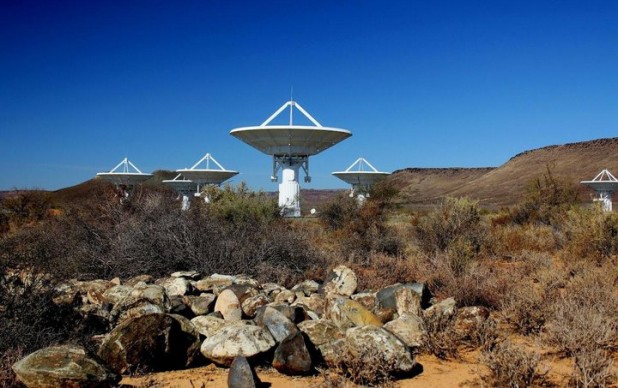 How's this for a daunting task? By 2017, IBM must develop low-power microservers that can handle 10 times the traffic of today's Internet—and resist blowing desert sands, to boot. Sound impossible? Hopefully not. Those are the design parameters of the Square Kilometer Array (SKA) Project, the world's largest radio telescope, located in South Africa and Australia amidst some of the world's most rugged terrain. It will be up to the SKA-specific business unit of South Africa's National Research Foundation, IBM, and ASTON (also known as the Netherlands Institute for Radio Astronomy) to jointly design the servers. Scientists from all three organizations will collaborate remotely and at the newly established ASTRON & IBM Center for Exascale Technology in Drenthe, the Netherlands. By peering into the furthest regions of space, the SKA project hopes to glimpse “back in time,” where the radio waves from some of the earliest moments of the universe—before stars were formed—are still detectable. The hardware is powerful enough to pick up an airport radar on a planet 50 light-years away, according to the SKA team. Discerning such minute amounts of radiation requires the construction of an enormous radio telescope: the SKA will be made up of 3,000 dish antennas, arranged in five spiral arms from the center of the core region. The dishes, each about 15 meters in diameter, will be arranged in the spirals leading at least 3,000 km from the center of the core region, accompanied by two other types of radio wave receptors. The mid-frequency aperture arrays will be built in South Africa and are envisaged to be a major component of the second phase of the SKA project, the companies said. Construction of the SKA should begin in 2017 and conclude in 2024. The combined surface area of the antennas would make up a square kilometer—hence the name—if mounted right next to one another. Since the antennas will be spaced so far apart, each must be connected to the others with enough optical fiber to circle the globe twice. When completed, the amount of data that the combined network will yield will be about ten times today's global Internet traffic, which was roughly 40,000 petabytes per month in 2013. If that's true, then the SKA will transmit 400,000 petabytes (~400 exabytes) per month—or a whopping 155.7 terabytes per second. The solution to handling that load, says IBM, is stacked, liquid-cooled microprocessors. IBM hasn't named an underlying architecture for the chips, possibly because it hasn't been invented yet. Whatever the eventual architecture, it will have to be optimized for low-power and high throughput. It's unclear what role these microservers will play; distributed nodes that serve as some sort of intermediaries seems somewhat unlikely, given that they must be ruggedized. They will apparently be tested against the existing 64 dishes of the MeerKAT telescope in South Africa, which will also be used for the testing and development of software used to help design SKA’s computing system. Last year, IBM and ASTRON formed a partnership, called DOME, to facilitate the computing roadmap. For IBM, participating in the project includes the same benefits as space exploration—by pushing computing to extremes, the company can take the resulting knowledge and apply it to more profitable ventures. "The DOME research has implications far beyond astronomy," Dr. Ton Engbersen, DOME project leader for IBM Research, wrote in a statement. "These scientific advances will help build the foundation for a new era of computing, providing technologies that learn and reason. Ultimately, these cognitive technologies will help to transform entire industries, including healthcare and finance. For example, we are designing a system for storing information that learns from its interactions with the data and parcels it out in real time to the storage medium that's most appropriate for each bit, which can also be applied to medical images." Building a low-power server to withstand the desert seems like a nearly impossible challenge. But if IBM and the Dutch can pull it off, the benefits could be enormous. Clarification/Correction: This story was updated to add Cisco's prediction for total fixed Internet traffic, which forced a recalculation of the corresponding data. Image: Flickr/IBM Research
How's this for a daunting task? By 2017, IBM must develop low-power microservers that can handle 10 times the traffic of today's Internet—and resist blowing desert sands, to boot. Sound impossible? Hopefully not. Those are the design parameters of the Square Kilometer Array (SKA) Project, the world's largest radio telescope, located in South Africa and Australia amidst some of the world's most rugged terrain. It will be up to the SKA-specific business unit of South Africa's National Research Foundation, IBM, and ASTON (also known as the Netherlands Institute for Radio Astronomy) to jointly design the servers. Scientists from all three organizations will collaborate remotely and at the newly established ASTRON & IBM Center for Exascale Technology in Drenthe, the Netherlands. By peering into the furthest regions of space, the SKA project hopes to glimpse “back in time,” where the radio waves from some of the earliest moments of the universe—before stars were formed—are still detectable. The hardware is powerful enough to pick up an airport radar on a planet 50 light-years away, according to the SKA team. Discerning such minute amounts of radiation requires the construction of an enormous radio telescope: the SKA will be made up of 3,000 dish antennas, arranged in five spiral arms from the center of the core region. The dishes, each about 15 meters in diameter, will be arranged in the spirals leading at least 3,000 km from the center of the core region, accompanied by two other types of radio wave receptors. The mid-frequency aperture arrays will be built in South Africa and are envisaged to be a major component of the second phase of the SKA project, the companies said. Construction of the SKA should begin in 2017 and conclude in 2024. The combined surface area of the antennas would make up a square kilometer—hence the name—if mounted right next to one another. Since the antennas will be spaced so far apart, each must be connected to the others with enough optical fiber to circle the globe twice. When completed, the amount of data that the combined network will yield will be about ten times today's global Internet traffic, which was roughly 40,000 petabytes per month in 2013. If that's true, then the SKA will transmit 400,000 petabytes (~400 exabytes) per month—or a whopping 155.7 terabytes per second. The solution to handling that load, says IBM, is stacked, liquid-cooled microprocessors. IBM hasn't named an underlying architecture for the chips, possibly because it hasn't been invented yet. Whatever the eventual architecture, it will have to be optimized for low-power and high throughput. It's unclear what role these microservers will play; distributed nodes that serve as some sort of intermediaries seems somewhat unlikely, given that they must be ruggedized. They will apparently be tested against the existing 64 dishes of the MeerKAT telescope in South Africa, which will also be used for the testing and development of software used to help design SKA’s computing system. Last year, IBM and ASTRON formed a partnership, called DOME, to facilitate the computing roadmap. For IBM, participating in the project includes the same benefits as space exploration—by pushing computing to extremes, the company can take the resulting knowledge and apply it to more profitable ventures. "The DOME research has implications far beyond astronomy," Dr. Ton Engbersen, DOME project leader for IBM Research, wrote in a statement. "These scientific advances will help build the foundation for a new era of computing, providing technologies that learn and reason. Ultimately, these cognitive technologies will help to transform entire industries, including healthcare and finance. For example, we are designing a system for storing information that learns from its interactions with the data and parcels it out in real time to the storage medium that's most appropriate for each bit, which can also be applied to medical images." Building a low-power server to withstand the desert seems like a nearly impossible challenge. But if IBM and the Dutch can pull it off, the benefits could be enormous. Clarification/Correction: This story was updated to add Cisco's prediction for total fixed Internet traffic, which forced a recalculation of the corresponding data. Image: Flickr/IBM Research
